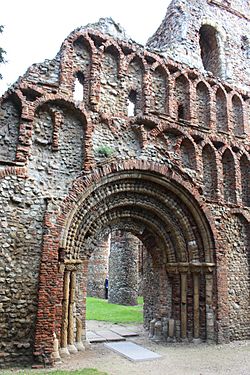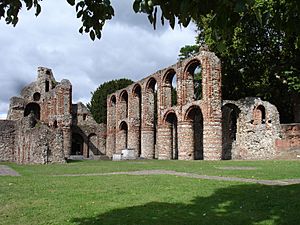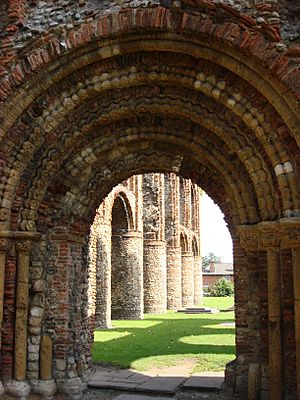St. Botolph's Priory facts for kids

Pardon Door of the Priory Church
|
|
| Monastery information | |
|---|---|
| Order | Order of St Augustine |
| Established | c.1100 |
| Disestablished | 1536 |
| Dedicated to | St Botolph, St. Catherine of Alexandria |
| People | |
| Founder(s) | Ainulf |
| Architecture | |
| Status | Dissolved |
| Heritage designation | Grade I |
| Site | |
| Location | Colchester, Essex, United Kingdom |
| Coordinates | 51°53′15″N 0°54′17″E / 51.8874°N 0.9046°E |
| Visible remains | Large portions of the nave church |
| Public access | yes |
St. Botolph's Priory was an important religious building in Colchester, Essex, England. It was home to a group of Augustinian canons, who were like priests living together under special rules. The priory was started around 1093. It was the very first and most important Augustinian house in England. The priory closed down in 1536 during a time called the Dissolution of the monasteries.
Contents
History of St. Botolph's Priory
How the Priory Started
Before the priory, an old Saxon church stood on the same spot. It was dedicated to St Botolph. A priest named Norman, who had studied in France, came to Colchester. He joined a group of priests at St. Botolph's Church. Their leader, Ainulf, wanted them to become part of a religious order.
Norman suggested the Augustinian order. At that time, there were no Augustinian houses in England. Norman went back to France to learn the rules of this order. When he returned, the church of St. Botolph became St. Botolph's Priory. Ainulf became its first leader, called the prior. This happened between 1093 and 1100.
Later, in 1108, Norman left to start another priory. In 1116, Pope Paschal II officially approved St. Botolph's Priory. This made it the first Augustinian place in England. Besides St Botolph, the priory also honored St Julian and St Denis.
Medieval Times at the Priory
Because St. Botolph's was the first Augustinian house in England, it was considered the most important. It had authority over other Augustinian houses. The priory was also free from control by most outside leaders. When a prior died, the canons would choose a new one.
Another priory, Holy Trinity in London, was supposed to follow St. Botolph's rules. But Holy Trinity disagreed. After a long argument, a decision was made in 1223. It said that Holy Trinity would be free from St. Botolph's control.
In the 1300s, there was a big disagreement between St. Botolph's Priory and St John's Abbey. The Abbey complained that the prior and some canons from St. Botolph's had caused trouble. They had argued over control of churches and land nearby. These arguments were settled the next year.
In 1380, the prior and canons told King Richard II that some people were pretending to work for them. These people were using fake letters to collect money from others. The king ordered these tricksters to be arrested.
In 1421, Pope Martin V asked people to donate money to help repair the priory. The priory was meant for a prior and twelve canons, but it had become poor.
In 1434, Prior John Depyng left St. Botolph's to become an abbot at another priory. He took valuable items from St. Botolph's and never returned them. St. Botolph's tried to get them back, but it seems they were not successful.
The Priory's End and Later Years
In 1534, the prior and seven canons promised loyalty to the King. This was during a time when King Henry VIII was changing the church in England.
The priory was officially closed in 1536. This was part of the Dissolution of the Monasteries. The priory and all its lands were given to Sir Thomas Audley. Later, he gave the priory site to John Golder and his wife.
Because St. Botolph's was an Augustinian house, its church was used by both the canons and local people. So, the main part of the church, called the nave, was kept as a local parish church. But the choir (where the canons prayed) and other buildings were pulled down.
The church remained until 1648 during the Second English Civil War. A Royalist army took over Colchester. The New Model Army surrounded the town and attacked it. St. Botolph's was caught in the fighting and was badly damaged. This is why it is now in ruins.
In 1837, a new church was built next to the ruins. The ruins themselves are now a public park. Between 2010 and 2012, improvements were made to make the ruins easier to visit.
The Priory Buildings
The Priory Church Design
The priory church was built in the Norman style. It was finished by 1177. The church was very long, about 53.7 meters (176 feet). It had a central tower and transepts (parts that stick out like arms). The main part of the church, the nave, was 33.5 meters (110 feet) long and 16.75 meters (55 feet) wide. The roof was about 13.7 meters (45 feet) high. The rose window at the front is thought to be one of the oldest in England.
The church had several smaller chapels. These included a lady chapel (for Mary, mother of Jesus), a chapel for St. Catherine of Alexandria, and one for St Thomas Becket. The lady chapel had a special lamp that burned all the time. By the early 1500s, there was also a chapel for the Holy Trinity.
The church had at least two bells. The main entrance was called the Pardon Door. This is where people received special pardons on St Denis's feast day. The cloisters (covered walkways) were on the south side of the church. The canons' sleeping area was updated in 1383.
The priory was led by a Prior. It usually had twelve canons, like the Twelve Apostles. In 1281, a man named Master Simon de Eylondia paid for a thirteenth canon. This canon would pray daily for Master Simon and his family. This agreement was confirmed by church leaders.
Later, in 1406, the priory agreed to have a canon pray daily for William Colchester, a former abbot. This canon would also celebrate William Colchester's anniversary. Money was set aside for the canon, for the poor, and for prisoners.
What the Priory Owned
St. Botolph's Priory was not as rich as its rival, St John's Abbey. However, it owned a lot of land in Essex and other parts of England. One early source of money came from land given by King Henry I. This led to some arguments with another priory, but they settled it in 1194.
King Henry also gave the canons a share of a mill in Colchester. He also said they had to provide him with a horse and supplies when he went to fight in Wales. King Richard I later confirmed these gifts and added more. These included churches in Gamlingay, Layer de la Haye, and Marks Tey. Later kings, Henry IV and Henry VI, also confirmed these possessions.
In 1291, the priory's yearly income from its lands was about £42. This included money from Colchester, Layer de la Haye, Gamlingay, and other places. They also earned money from churches in Hatfield Regis, Witham, Boxted, Frating, and Reydon. The church of St. Peter in Colchester became part of the priory in 1318. The church of Chigwell joined in 1440.
The priory also owned land around Colchester, including at Greenstead and Cannock. They owned several watermills in and around the town, like East Mill and Cannock Mill.
Leaders of the Priory
St Botolph's Priory was led by a prior. The prior's official seal showed Christ blessing two figures, St. Julian and St. Botolph.
Here is a list of the priors of St Botolph's:
- Ainulf or Eynulph (first prior, around 1116)
- John (around 1145)
- Henry (around 1205-1206)
- Robert (around 1222)
- Hasculph (around 1224-1240)
- John (around 1246-1259)
- Simon (around 1281)
- Richard (around 1290-1295)
- John de Colum
- Richard le Brom (around 1323)
- John (around 1326-1338)
- Thomas Sakkot (died 1361)
- John (around 1363-1364)
- John Neylond (around 1374-1384, resigned 1391)
- John Okham (elected 1391, resigned 1393)
- William Westbrome (elected 1393, around 1412)
- William Colchester (around 1416)
- John Depyng (around 1424, resigned 1434)
- John (around 1437)
- Thomas Colman (around 1450)
- John Wardhous (around 1457)
- John Flyngaunt (around 1462)
- John Stampe (around 1497)
- William (around 1514)
- William Gooche (died 1527)
- Thomas Turner (elected 1527, the last prior)



